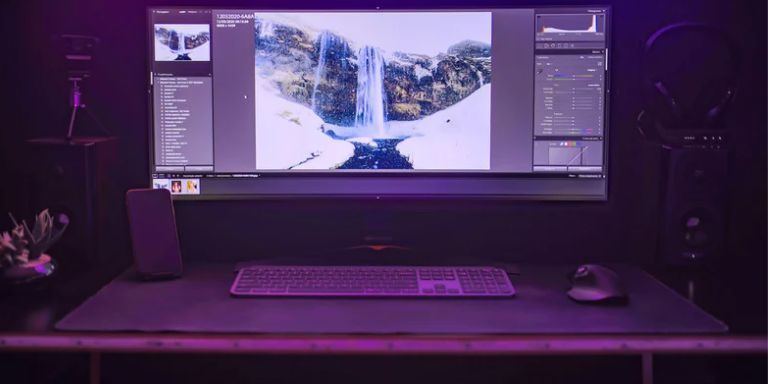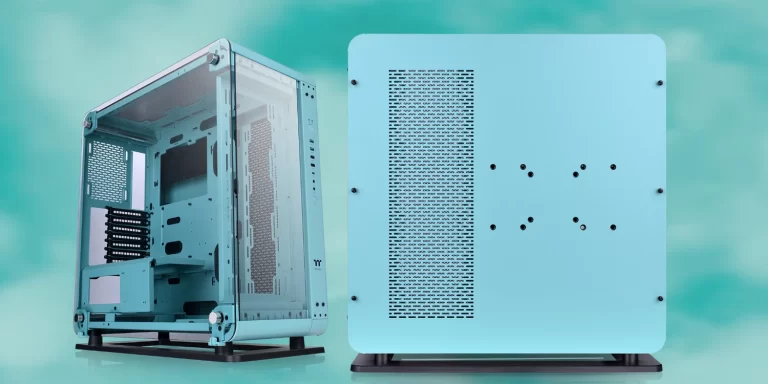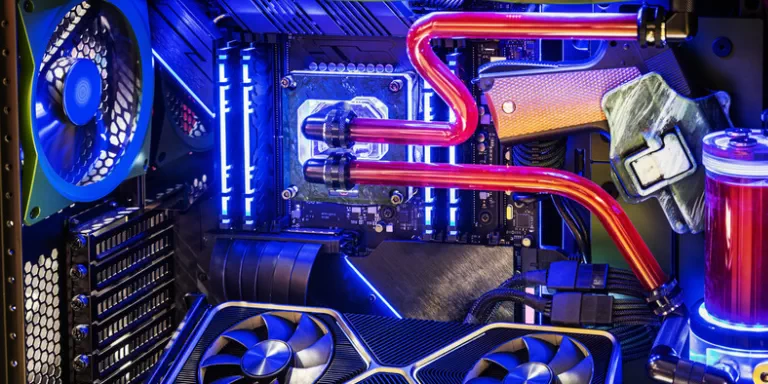
Finding a PC case for building your computer is quite an exciting job. What makes that the case? A few years ago, PC cases were usually just square rectangular towers with closed walls on both sides. However, today with all the available choices for functionality and style, you have a ton of options. But choosing the right ones is never simple, especially when it comes to PC case size.
You certainly never expect to buy a PC case only to find out later that it has a lot of annoying issues. This is largely because you have not properly researched the important factors involved. PC cases serve as more than just a protective shell for your computer; they also need to allow for adequate cooling and ventilation. It must also match your preferences in terms of appearance, of course.
Here we will go into more detail about the types of PC cases. You will learn what computer configuration could be used for each different PC case size through specific recommendations.
PC Case Size
The hardware you select to install in your PC is intimately tied to the size of the PC chassis (form factor). So there are several factors that you need to consider when choosing a case.
1. It should have enough space for you to install essential components such as motherboard, graphics cards, cooling system, PSU, Drive Bays.
2. Adequate ventilation and cooling should be provided for the main components inside the case such as CPU, GPU.
3. The size must be reasonable to fit where you work.
As per our survey, the size of the motherboard can be used to classify PC case size as follows:
| PC Case Form Factor | Motherboard Max. Size | Max. Expansion Slots | Height |
|---|---|---|---|
| Full-Tower | E-ATX, SSI EEB | 7 | 560 – 750 mm (22 – 30 inches) |
| Mid-Tower | ATX | 7 | 450 – 550 mm (18 – 22 inches) |
| Mini-Tower | microATX | 4 | 360 – 420 mm (14 – 17 inches) |
| Small Form Factor | Mini-ITX | 1 |
Unlike motherboards, there is actually no standard for PC case size. Even some of their form factor names can be assigned in various ways, as shown in the table below:
| PC CaseForm Factor | Motherboard Max. Size | Other Name of Form Factor |
|---|---|---|
| Mini-Tower | microATX | – Micro Case (by Thermaltake) – Micro Chassis (by Phanteks) – Micro-ATX Chassis (by SilverStone) |
| Small Form Factor | Mini-ITX | – Mini ITX (by Cooler Master) – Mini-ITX Tower (by NZXT) – Tiny Form Factor (by SilverStone) |
Therefore, we’ll classify PC case sizes based on the motherboard form factors that they support.
ATX Case
The ATX case is often referred to as the Mid-Tower. This is the most popular PC case size. It enables the placement of Intel ATX motherboards with dimensions of 12″ (height) and 9.6″ (width). The height ranges from 450 to 550 mm (18 – 22 inches). You have a lot of customization options for this type of PC case.
Common Layout
Obviously, there is no standard layout for ATX cases. They are designed differently, specific to each manufacturer. However, most of them have a common layout as shown below.

The ATX case will be divided into two main compartments. The main chamber will be the place to mount the motherboard along with its components, ventilation and cooling systems. The second chamber right behind the motherboard will be the place for cable management to ensure a clean and tidy space for the main chamber. This area can be fitted with racks for additional 2.5″ drives and RGB lighting controls.The bottom will be where the PSU and drive bays are located.
Motherboard
ATX case supports ATX motherboard installation. However, there are some brands that allow the installation of an extended ATX that is wider than 9.6″.

IMPORTANT NOTE:
When using an ATX case you can always install smaller motherboard form factors like microATX, Mini-ITX or Mini-DTX as they share the same mounting hole arrangement on this case.
Cooling and Ventilation
The fan for air ventilation can be installed on the front, back and top of the case. Common fan diameters are 120mm or 140mm. Meanwhile, radiators for liquid cooling are often chosen to install on the front. In some circumstances, it can be mounted on the roof of the case.
RELATED: Optimal PC Case Airflow: How To Position Your Fans And Radiators

With the option of a liquid cooling custom system, you need to pay attention to the reservoir location. Usually it is located between the motherboard and the front of the case. You should then double-check the manufacturer’s instructions for the dimensions involved to make sure they will be properly mounted.

RELATED: Is Liquid Cooling Worth It?
Second Chamber for Cable Management
The second chamber is located behind the motherboard. It is the area for cable management. It hides most of the cables in your PC. Manufacturers may include velcro straps or zip ties so that cables can be routed neatly. In addition, this area can be a place to mount 2.5″ drives and RGB lighting controllers.

The lower compartment is used to mount the PSU and drive bays. Most drive bays are adjustable for easy cabling into the PSU.
microATX Case
microATX motherboard is a variant of ATX form factor. Its height is less than standard ATX, measuring 9.6″ in height and 9.6″ in width. This helps to shorten the height of the microATX case. Its typical height is around 360 – 420 mm (14 – 17 inches) and is often referred to as the Mini-Tower case.
Common Layout
The microATX case is small in size. This is considered a modest sized PC case but is still fully equipped with features. Passionate gamers can also install a liquid cooling system. However, the maximum radiator size is commonly 240mm only.
The layout inside the microATX case is also designed like an ATX case with the main chamber in the left and cable management in the right. The PSU and drive bays are located at the lower side.

There are also some PC cases where the internal space is reduced. The manufacturer removed the side compartment for cable management. The layout of the PSU, motherboard and drive bays is the same as Intel’s design in the ATX Specification shown below.


Mini-ITX Case (Small Form Factor)
The motherboard form factor known as Mini-ITX was created by VIA Technologies. It has dimensions of 6.7″ in height by 6.7″ in width and can only accommodate one graphics card. Because of their tiny size, they are frequently referred to as Small Form Factors (SFF).
And obviously with its modest size, the interior layout of this case is minimal for the basic functions of a PC. For this kind of case, manufacturers have created quite a few different designs. They could be horizontal boxes, tower PCs, or cube PCs. These little PCs are frequently used for computers with basic configuration needs. Additionally, they can be utilized as Home Theater PCs (HTPC) for activities like movie watching and music listening at home.
E-ATX Case (Full-Tower)
In an effort to increase the number of RAM and CPU, manufacturers have attempted to increase the width of the ATX motherboard. E-ATX (Extended ATX) is a term for such motherboards.
It is a motherboard that is wider than the standard ATX. With that in mind, this is the most misleading motherboard form factor because with the same name as E-ATX but their sizes can be different. For example, they could be E-ATX (12″ x 10.1″), E-ATX (12″ x 10.4″), E-ATX (12″ x 10.5″), or E-ATX (12″ x 10.7″).
The E-ATX motherboard can accept a maximum width of 13″. And we understand that the E-ATX case is for motherboards of 12″ in height and 13″ in width. They are often referred to as Full-Tower cases.
Full-Tower is used for servers or high-end graphics or gaming computers. Its height is about 560-750 mm (22 – 30 inches). This is the largest case size, and obviously you have a huge selection of high-performance components and cooling options available.
RELATED: Mid-Tower Vs Full-Tower: What You Need To Know For Your Build
Select Your Desired PC Case Size
Mid-Tower is the most common option among many users. There are a variety of cooling methods and graphics card sizes available. Furthermore, this case provides you with excellent cable management, ensuring cooler system and PC aesthetics.
If you prefer a compact PC that can also play games, the Mini-Tower (microATX case) will be your choice.
The Full-Tower case will be ideal for enthusiasts who are willing to pay a high price and put up with a large size in exchange for the thrilling gaming features it offers.
And if you want to enjoy entertainment innovation from your PC at home, the HTPC with Mini-ITX motherboard is great for you to relax with your home TV and sound system.
We have categorized and evaluated all of the aforementioned choices as being reasonable. Hope you will make the right choice.









